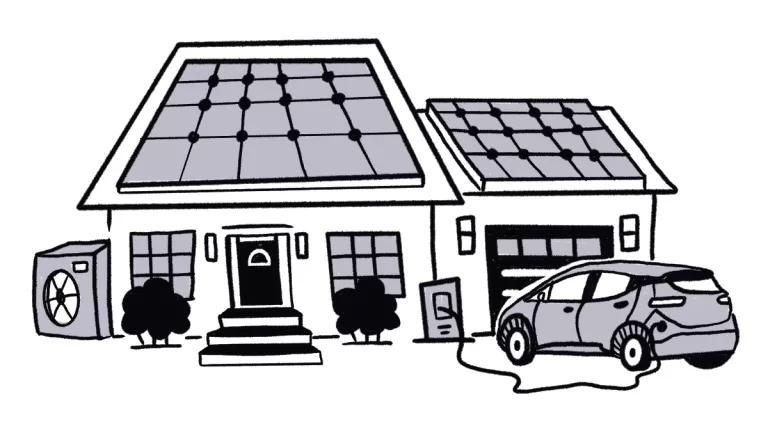Reforming CA's Electric Rates for Decarbonization and Equity
NRDC and The Utility Reform Network submitted an electric rate design proposal to the California Public Utilities Commission to promote equity and encourage beneficial electrification. This is the first stage in a regulatory process to implement income-based fixed charges.

Micheile Henderson/Unsplash
NRDC and The Utility Reform Network (TURN) have submitted a proposal for electric rate design that encourages electrification while enhancing equity. Low-income Californians will start saving between $10 and $40 in electricity bills each month if our proposal is adopted. All Californians would also significantly increase the amount of money they save when they electrify by switching from gasoline cars and polluting appliances to clean electric alternatives.
Background
California’s high electricity rates hinder energy affordability and discourage Californians from adopting clean electric technologies. As we previously explained, Assembly Bill 205 requires incorporating an “income-based fixed charge” in residential rates to help address this problem. The California Public Utilities Commission (CPUC) started a proceeding to act on this new directive.
Fixed costs are the costs of maintaining and operating the grid that don’t change with electricity use. If customers pay for these fixed costs via a monthly fee, utilities and community choice aggregators (CCAs) can charge lower rates for each unit of electricity customers consume. This makes it cheaper to use electricity to operate electric cars or appliances. Basing this fixed charge on a customer’s income makes electricity bills even more affordable for lower income customers.

Electricity rates before and after inclusion of an income-based fixed charge
Jessica Russo/NRDC
There are two root causes of high electricity costs in California. The first is the size of the overall revenue requirement, or how much money the CPUC authorizes utilities and CCAs to collect via customer bills. The second is how this money is collected. Rate design, which this proceeding and blog are about, only addresses the second issue. Broader policy reform, such as leveraging other funding sources for social objectives like wildfire mitigation and continued scrutiny of utility spending are necessary to tackle the first issue of keeping utilities’ spending in check.
The NRDC-TURN Joint Proposal Addresses the Rate Design Problem
Our proposal reduces electricity bills for low-income Californians, encourages home and vehicle electrification, and is implementable in the next couple of years. We recommend an average fixed charge of $37 that would be income graduated in three tiers. This new fixed charge reduces the price of electric consumption, or the volumetric rate, by 20 to 25%.
Low-income Californians with household incomes up to 250% of the Federal Poverty Level, already eligible for discounted energy bills under the CARE and FERA programs, would pay a $5 monthly fixed charge. Middle-income customers with annual household income up to $150,000 would pay approximately $40, and higher income households would pay around $62. The exact fixed charge varies by utility due to each utility’s customer characteristics and CPUC-approved revenue requirements.
Customers would be automatically enrolled in the low-income tier if they already participate in CARE or FERA. Middle-income customers would receive targeted prompts to confirm their income and enroll in the middle tier. Remaining customers would default to the high-income band. An appeals process would give all customers an opportunity to ensure that they are sorted into the appropriate income tier.
The NRDC-TURN Proposal Encourages Beneficial Electrification and Efficiency While Making Electric Bills Progressive
Enhance Affordability
Low-income customers, who tend to pay a disproportionately high share of their income on household utilities, will benefit the most. As a result of the new income-based fixed charges and lower volumetric rates, low-income customers in all parts of the state would realize savings between $10-40 per month on average. Middle-income customers would see minimal bill impacts, and high-income customers will see average bill increases between $7-35.
Bill savings are also highest for Californians who live in warm inland areas as they tend to use more electricity than those in temperate coastal regions. On standard time-of-use rates, for example, we found that low-income customers in SDG&E's coastal region would save an average $14 each month; however, savings average $40 a month for those low-income customers in SDG&E’s warmer inland desert region.
Further Encourage Electrification and Maintain Focus on Efficiency
Our proposal makes it significantly more appealing for all customer groups to adopt clean electric technologies such as electric vehicles and building appliances. To this end, we recommend that the CPUC also order utilities to update their current electrification rates (such as PG&E’s E-ELEC or SDG&E’s TOU-ELEC) to include a slightly higher income graduated fixed charge than what we propose for the new default rates. This will ensure even lower volumetric rates to incentivize more clean electricity use.
For example, on SCE’s current pro-electrification rate (TOU-D-PRIME) a high-income coastal customer can currently only save $30 in annual operating costs when they electrify their space and water heating. Under our proposal those savings would nearly quintuple to total $142 each year. These improvements are even more pronounced for electric cars. On SDG&E's pro-electrification rate, for example, high-income customers could pay $93 more each year when they switch from a gasoline to an electric car. With the proposed rate reform, those customers would save nearly $300 each year.
In addition to encouraging electrification, our proposal retains incentives for energy efficiency and conservation. Prices to consume electricity in California will remain high enough to encourage customers to be energy efficient, even with the fixed charge.
Next Steps
Opening testimony is the first step toward rate reform. Next, all stakeholders will have a chance to critique each other’s proposals and modify their own proposals in early June. The CPUC will finalize new rates by summer 2024.
AB 205 provides a unique opportunity to implement a progressive fixed charge that can help align residential rate design with the state goals of prioritizing affordability, equity, and beneficial electrification. NRDC’s proposal offers a pragmatic and implementable first step for this rate reform.




